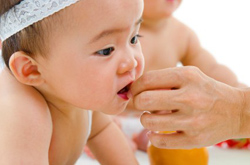9 Doctor-approved Tips to Survive Teething

by Victoria Scanlan Stefanakos
Teething is a milestone for babies, but some parents won’t find much to celebrate in the sore gums, endless drooling and general unhappiness that often precedes new teeth. Having the right information and some soothing strategies helps make everyone more comfortable. Here, nine teething tips to help make this challenge more bearable:
Teething Tip No. 9 − Start with the facts.
“At 4 months old, most babies are starting to jam things into their mouths. It’s not that they’re teething; they’re just exploring,” says Paul Ritger, a pediatrician based in Portland, Maine. True teething begins at 6-8 months, and unfortunately, teeth don’t simply erupt. Instead, they twist and shift as they make their way up from under the gums.
Teething Tip No. 8 − Apply gentle pressure.
Massaging gums with wet washcloths or gauze — and even clean fingers — can help relieve discomfort, according to Shari C. Kohn, a dentist, a spokeswoman for the American Academy of Pediatric Dentistry and an expert columnist for Healthy Kids From Teeth to Feet. Wiping their gums fends off bacteria too, which can prevent inflammation later on.
Teething Tip No. 7 − Protect their skin.
Babies’ extra drool can cause face rashes and mild diarrhea, which can cause diaper rashes. Protect their chins and bottoms with ointment before and during these spells.
Teething Tip No. 6 − Keep them hydrated.
Drooling and reduced appetites can keep babies from getting enough liquids. Offer lots of their favorite cold liquids.
Teething Tip No. 5 − Chill sore gums.
A new, wet, frozen dishtowel is great for little teethers to gnaw on. For older ones, frozen bananas, celery, carrots, popsicles, and even mini bagels and waffles might do the trick. (If you use teething rings, check labels to see which ones you can chill and which you can freeze, advises Kohn.)
Teething Tip No. 4 − Keep them rested.
Tired babies are cranky, so honor their regular nap schedule. If teething pain keeps them awake, pain relievers such as Tylenol, Motrin and Advil can help; just be sure to carefully follow the package dosing instructions. After giving your baby the medication, wipe off any teeth they do have, as those syrups contain sugar.
Teething Tip No. 3 − Target pain relief.
If you opt for topical pain relievers (such as children’s Anbesol or Orajel), Kohn suggests using a Q-tip to dry the sore area first. Apply the gel with the other end, and then hold a piece of gauze over the area to help the medication soak in only where it should.
Teething Tip No. 2 − Be aware of blisters.
If you see a small blood blister over the area where the tooth will erupt, don’t panic. It’s perfectly normal, says Ritger. So are teeth that emerge crooked, discolored or widely spaced. Those stains will wear off as babies start eating food.
Teething Tip No. 1 − Don’t chalk it all up to teething.
Not all symptoms are related to teething. If your baby has a runny nose, drainage from the eyes, or a fever of more than 101.3 F, it’s probably a virus, according to Ritger. If those symptoms become progressively uncomfortable, call your doctor.
Victoria Scanlan Stefanakos has written for numerous publications and websites, including Martha Stewart Living, Real Simple and iVillage.com.




